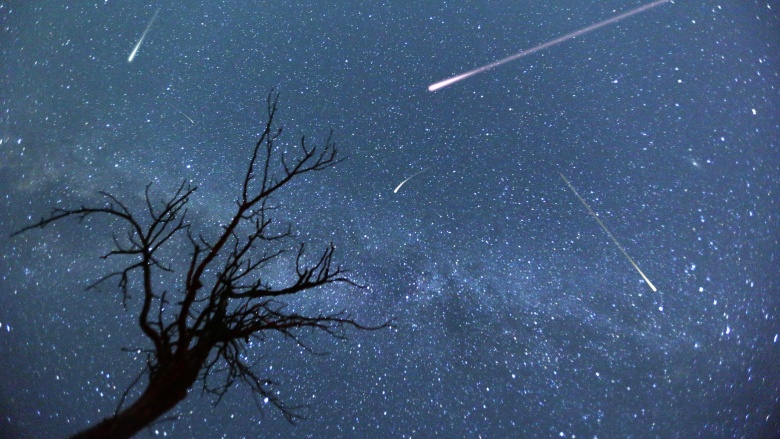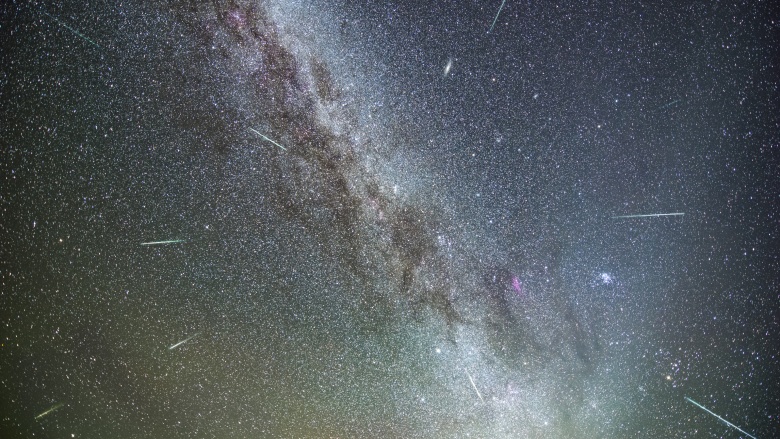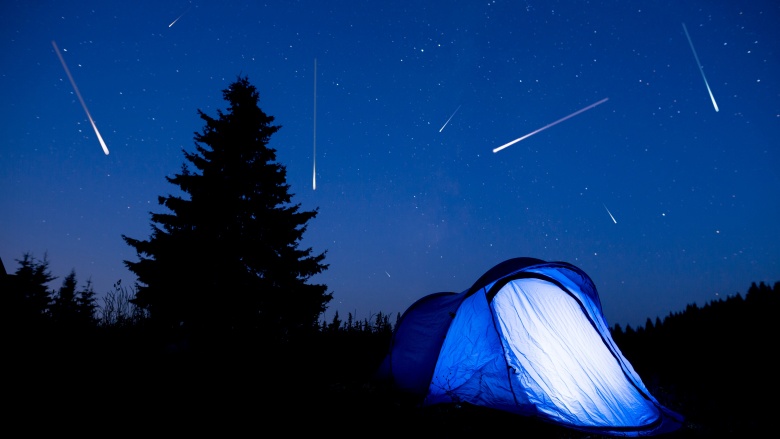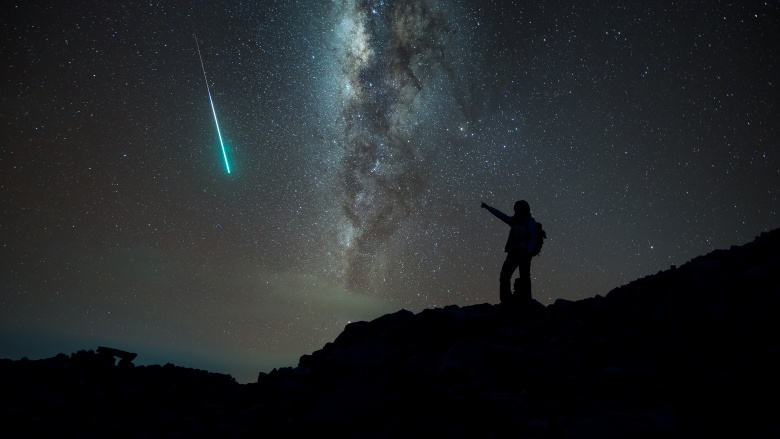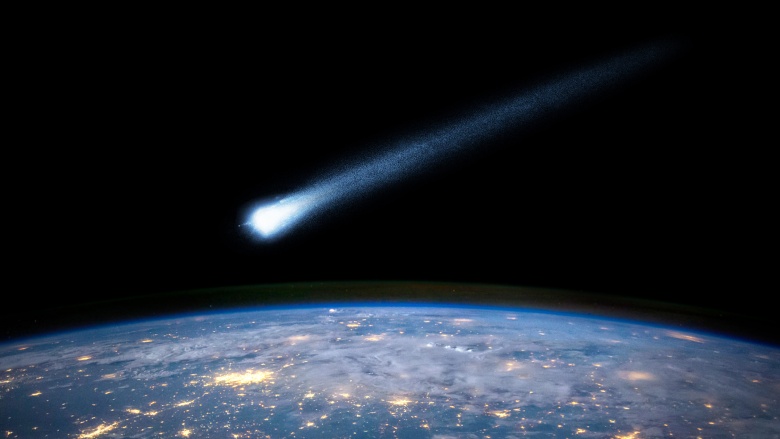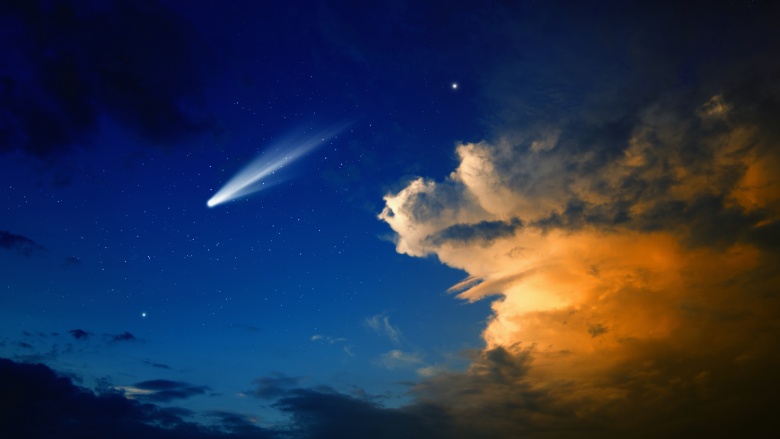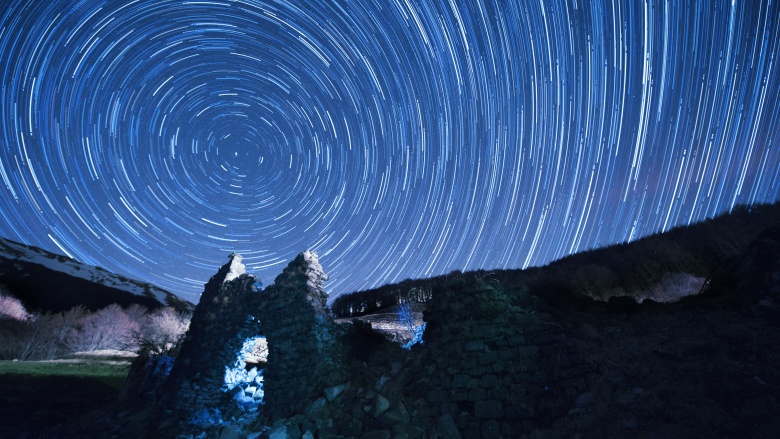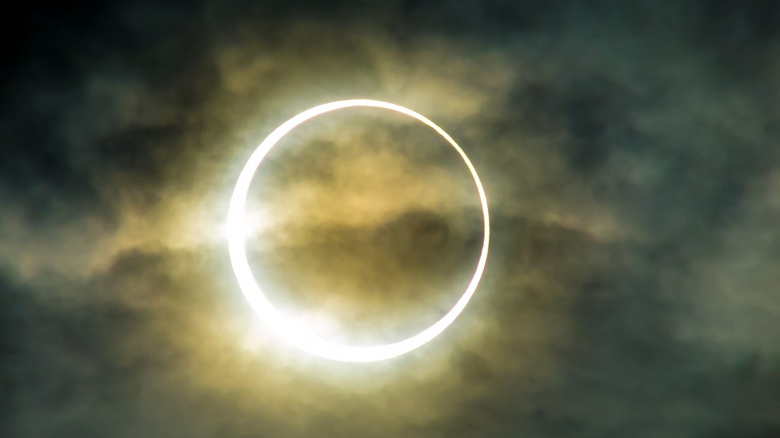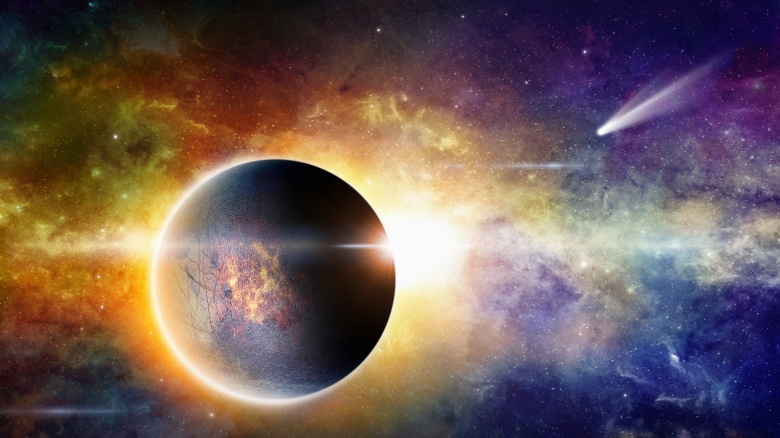False Facts About Objects In The Sky You Thought Were True
How often do you go out and look up at the sky? It's probably not often enough, in this modern era, and it's kind of sad that our nightly sky-watching has been taken over by things like reality TV. On the off-chance that you do make it out of your house every so often, to look up at a passing comet or that meteor shower you heard about on the news, chances are pretty good you've still got a few misconceptions kicking around from grade school. Let's set some of those right.
Meteors can reach the Earth's surface
This one's a bit of a technicality, but if you want to be a hit at parties, technicalities are the stuff you want to pull out of your pocket. (Trust us.)
Meteor showers always make the news when they happen on a relatively large scale, and if you find a piece of space rock that's made it through the atmosphere to hit the ground, you could be sitting on some decent money. Those aren't meteors, though — they're meteorites. The name change happens when they hit the ground, and in spite of the "-ite" that gets tacked onto the end of their name, they do start out as the big guys. (Adding to the confusion, they're not meteors until they hit Earth's atmosphere. While they're in space, they're meteoroids.)
It's only the biggest meteors that survive some grueling conditions to make it to Earth, and that includes speeds of around 30,000 mph, temperatures of 3,000 degrees Fahrenheit, and possibly a mass extinction event. It's no wonder then, that most don't make it through the atmosphere without completely disintegrating, as most do that at least five miles above the planet's surface. Others, just plain explode.
It's relatively rare that large pieces of space rock make it through to the surface, where they can blast out craters way bigger than you'd think they could. Smaller ones are common-ish, and about 5 to 10 percent of all meteors become meteorites. That's an important point to make next time people around the water cooler are talking about the evening's meteor shower. They'll thank us, and you should, too.
Meteor showers are massive … showers
How many coworkers have you heard getting really excited because there's going to be a massive meteor shower over the next few days? They're probably thinking there's going to be a major, well, shower of lights arcing across the sky, and it's important that you correct them about that right now. (Also, trust us.)
While there won't be a sky full of shooting stars, there will be a greater chance of seeing some if you have the patience ... and that makes the term "shower" just a bit misleading. Different meteor showers will have different frequencies, with the biggest, most intense showers (like the Perseids) capable of creating up to 100 shooting stars every hour. On a slower day, a particular Perseids shower might only spit out about a meteor a minute, and some of the lower density showers? You're only looking at around 5 to 10 every hour. There's still other meteor showers that are even harder to see, with some known for only having one or two visible every hour, at least from our vantage point here on Earth.
Just how frequent meteors are isn't constant, either, and you might go relatively long periods of time without seeing anything, even though the local news station talked it up like it was going to be the next great astronomical event. Unfortunately, that means meteor showers aren't just something you can expect to enjoy during a quick commercial break, but they're a good excuse to do nothing else but stargaze for an evening.
Meteor showers are pretty random
All that being said, there's no reason for you to be standing outside, trying to look everywhere in the night sky at once in hopes of catching sight of one of the meteors as they're flashing by. You can totally hack meteor showers, as they're not really random at all.
The big meteor showers you hear the most about are given names. We'll take the Orionids for our example, and why will be obvious in a minute. The Orionid meteor shower happens every year at the end of October, and it's so regular because it's the same time every year that Earth passes through the orbit of Halley's Comet. Even though the comet's obviously not there, it's done its orbit so many times, it's left a huge amount of debris behind, and that's what we're seeing in the Orionid meteor shower.
So why's it called the Orionid? Because all the meteors you're going to see will look like they're coming from the same area of the sky — from our vantage point, that's the constellation Orion. We picked this as our example because everyone knows how to find Orion in the night sky, even if you couldn't identify any other constellation if your life depended on it.
Earth passes through the comet's orbit twice, because that's how orbits work. The other shower happens in May, and even though the sky gets a little busier with this Eta Aquarid shower, it's mostly seen from the Southern Hemisphere, and we're guessing that not as many people know where to find that particular constellation. It's also called the Water Jar, and what, you didn't know that?
Shooting stars are always the same color
One more on meteors, then we'll move on to debunking everything you thought you knew about other bodies in our night skies. (We're not sorry.)
Shooting stars are all the same color, right? Sort of whitish? You know, the color of most of the stars in the sky. Well, not exactly, but no one's quite sure how to quantify any of this. Some people have observed shooting stars that are red and blue, and sometimes, something in between.
Part of the problem obviously comes in identifying different colors of meteoroids, and there's a few different things at work here. The speed at which a meteoroid is moving likely has something to do with it (slower ones usually appear red or orange), and different mineral and rock compositions can impact color, too. Only about 5% of the aura a meteoroid puts off comes from its own composition (the rest comes from the space around it), and that means that sometimes, the color isn't a constant. A sudden burn-off of nickel, say, will produce a geren color, but it's unlikely to last long.
There's also the problem of our own color vision (and the limits of that vision). What we see tends to be occasionally unreliable, but the moral of the story is that it's perfectly possible to see something other than white fireballs shooting across the night sky.
Comets are made of rock
We hear so much about the fruitless search for water on other planets, it's easy to forget that there really is water out in space, and Earth isn't that special after all. Comets, far from being boring old rocks, are mostly made up of ice, dust and gases like carbon dioxide and methane. Astronomers have all kinds of nicknames for them, calling them things like snowy dirtballs and ... dirty snowballs. (We didn't say they were creative nicknames.)
Figuring out just how things like water came to Earth has always been a tricky bit of business. One hypothesis states that the first bits of water were brought by a comet that impacted the surface of the planet a long, long time ago. That's made them pretty interesting, and well worth the expeditions to see what else they're made of, and in 2005, one of NASA's probes got up-close-and-personal with a comet called Tempel 1. It got so close, in fact, that it got a sample of what's in the nucleus of the comet's head. If you're expecting at least a bit of solid rock, you'd be wrong about that, too. Not only is the central structure of a comet fairly weak, but it's literally full of holes. Think more "sponge" than "boulder," and that's what's really flying through space: dusty, gassy, icy Spongebobs.
Comets always have tails
Sketch the profile of a comet, and you'll probably draw a round bit at the front and a tail. That's how you know it's a comet, right? The tail? Only, not so fast.
First, a bit about what they do. As comets zip along through space, they shed bits of themselves. (And now, you also know that's ice, rather than rocks.) That's what creates the tail, for most comets. In 2016, scientists found a weird comet that emerged from the Oort Cloud, which is the home of most comets we've found so far. Every few hundred years, their orbit brings them through our solar system, and we know them by those distinctive tails. This particular comet, though, doesn't have a tail. It also doesn't have the huge amount of ice that most comets have, either and, according to its spectrum (which is an astronomical thing that scientists can use to identify bodies as they move through space), this particular comet hasn't been close enough to the Sun with any regularity to be fried to a normal, extra-crispy state.
So, you're asking, why is this thing considered a comet at all? It's deemed so because of its orbit, which makes some scientists think they're going to have to do some serious re-writing regarding the definition of a "comet." Y'know, like they did with planets. You're not the only one who learns something new every day.
The North Star is the brightest star in the sky
Quick, what's the brightest star in the sky? While there's technically only one right answer (it's Sirius, also known as the Dog Star), there's more than 40 other answers you can give and still be more right than you would be if you said "the North Star."
Look up into the night sky, and you'll see Polaris, the one that's not moving much. That's why it's important: it's easy to find (it's part of the Little Dipper), and it's as north as you can get. Head toward it, and you'll always be heading north, and if you're at the North Pole? It'd be directly overhead. It's definitely not the brightest, but it's still pretty bright. Even being in the top 50 brightest stars means that you'll probably still be able to see it if you're standing on a city street, and you'll almost certainly be able to see it if you're in a small town.
That's Polaris, and what kind of cool things should you know about the actual brightest star, Sirius? It's part of the Canis Major constellation, and it used to make its appearance in the night sky in mid-summer. That's why we call the hottest part of the summer "the dog days," even though the Earth has wobbled enough that it's no longer really makes sense. That wobble and the changes in the night sky bring us back to the North Star, and our next debunking...
Polaris is Earth's only North Star
More precisely, Polaris is Earth's present-day North Star and, technically, it's not even exactly accurate. It won't be, and its constant movement means that it'll only be mostly exact on March 24, 2100, when most of us will be too dead to notice. Why? Because of that wobble we mentioned, which is sort of a weird way to describe just what the Earth is doing.
The term "wobble" seems to imply that it's happening pretty quickly, because nothing wobbles slowly, not even Weebles. But that's what the Earth is doing, at least, from the point of view of our short lifespans. A single wobble takes the planet 25,800 years, and over that time, the planet's pole points to different stars. Go back to the time the Pyramids were being built, and the North Star was Draco's Thuban. Plato knew a different North Star, that was being Kochab. A few thousand years ago, the North Star was a star called Vega, and in about 12,000 years, Vega will be our North Star once again. (The picture above is of it, and where it sits in the constellation Lyra.) Whether or not the human race will be around to see it, that's another matter entirely.
A total solar eclipse is rare
It's one of those things that everyone makes a big deal out of, so when it does happen, it's got to be a rare occurance, right? Well, because we're all about bursting your bubbles, we're here to tell you that solar eclipses aren't rare at all.
In fact, they're the opposite of rare. Total solar eclipses (which only happen because of the bizarre coincidence that the Sun is 400 times bigger than the Moon, but the Moon is 400 times closer to us) happen once every 18 months. And partial eclipses happen even more often, up to three or four times a year. Most of those can only be seen from certain points on the globe, but just because you can't see them, that doesn't mean they're not happening.
That's really the only reason total solar eclipses seem so rare. You have to be in exactly the right spot to see them, and it only takes a few thousand miles (which isn't much, if you ask space) to turn a total eclipse into a partial one. In order to see the full thing, you need to be in the path of totality, which honestly sounds like something you don't want to be in for any reason.
Comets (and space) clearly don't have a smell
In space, it's said, no one can hear you scream. But what about smells? If sound can't exist, it makes sense that scents can't either ... right? But they do, sort of, and we know what at least one comet smells like, all thanks to the Aroma Company, and the team behind the 2014 Rosetta mission.
Rosetta landed on a comet called 67P/Churyumov-Gerasimenko, and it reported the presence of things like hydrogen cyanide, ammonia, and hydrogen sulphide (among other things like carbon dioxide, which doesn't have a smell). The information the probe gathered allowed the team to turn around and give the data to a British perfumery, who then made a scent that mimiced what the comet smelled like.
If those above-mentioned compounds suggest anything in particular to you, it's probably nothing good. In fact, if you assumed Eau De Comet smells like rotten eggs and not a small bit of urine, you'd be right. Determining the smell of something floating through deep space is a little odd, and it's probably more accurate to describe it as the smell the comet would have if it came to Earth. Based on the descriptions of those who have smelled it, it's probably better that it stays way, way up there.

